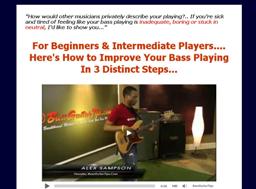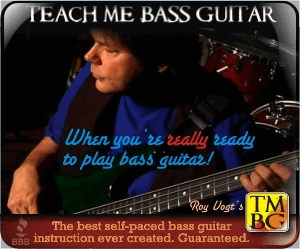Advanced Bass Lessons

Scroll down for lessons…
So, you had been playing the bass for some time and you are already familiar with the basics and intermediate aspects. How do you take your skills to a higher level and continue growing as a musician?
In this new section of our website, we will teach you how to go beyond the usual bass rhythms and notes being played. We will show you how to inject your own personality into a piece of music and create your own signature sounds. You will also learn how to improvise on the fly even if you are thrown a piece of impromptu music.
Before that, here’s a fair warning that I want to extend to you in order to avoid disappointment and frustration. In my 15 years as a guitar teacher, I had often seen students who overestimated their own capabilities only to “crash and burn” in the advanced stages. Because their expertise of the bass guitar hasn’t been fully developed to a certain level, it is really tough for them to progress beyond this stage.
Overtime, a vicious cycle starts to form as these students get stuck “in a plateau” when trying to master new material. By losing motivation when things don’t go their way and approaching practice sessions with a poor mindset, their performance takes a hit which really hinders learning. In many scenarios, I had seen a fair amount of students lose interest and give up playing the bass all together when they find themselves being stagnant for a long time.
Don’t Lose Sight of Your Goals And Have Fun!
At BassGuitarPlayerWorld.com, the aim of these advanced bass lessons is to help you become a better musician and not to demoralize you in the instrument. If you think you aren’t ready to handle the more technical aspects of bass playing or if you need some refresher courses, I highly recommend that you refer to the other sections of the site again.
Practice takes time and everybody’s aptitude in learning is different. By taking your own time in building a strong foundation, it will enable you to grasp the concepts that are taught here at a faster pace.
Lastly, do not get overly frustrated when you stumble across something difficult. Experiencing some difficulty is good because this means your brain is learning and processing something new. You are probably your own worst enemy when it comes to pushing yourself beyond limits.
Take short breaks in between practice sessions and try to break down the lessons into chucks. I personally find this approach of learning new stuff an easier process because the mind can cope with the influx of new knowledge better. Sometimes, taking a 15 minutes break and coming back to a section you got stuck can actually do wonders.
Remember, more haste usually equals to less speed.
Get Comprehensive Step-By-Step Lessons Via HD Videos
Bass Guitar Instructions for Advanced And Intermediate Players:
#1 – Shuffle And Swing Rhythms That Enables You to Get the Groove
Playing the bass is all about getting the groove correct. In shuffle and swing music styles, setting up the rhythm is critical to get the music going. This lesson is designed with helping you out with easy examples.
#2 – Bass Sliding Fingerings And Easy Application With Scales
A video tutorial and exercise for you to practice your bass sliding techniques. With the use of scales and basic theory, it can allow you to connect the dots and help you out on your fretting.
#3 – Things You Can Do to Increase Your Bass Playing Speed
I get asked this question very frequently. “How do I increase my bass playing speed?”. Besides the mind numbing hours of practice and countless amount of sweat placed into the process, a good routine and practice plan is required if you want to excel.
#4 – 3 Notes Sequences And Patterns Across the Fretboard
A 3 note sequence basically involves the playing of 3 notes per string as your hands move down or up the fretboard. Why? Well, the reason behind this is that it creates the most economical method for your fingers as you move across strings while conforming to a pattern.
#5 – Alternate Tunings That You Can Experiment With
While playing in standard tuning is a great thing, it severely limits what you can do with the bass guitar. Because of that, many alternative tunings had been developed and experimented by bassists, leading to the creation of new sounds and ideas.
#6 – How to Use the Circle of Fifths And Apply it Practically
The circle of 5ths is basically a diagram that shows us the properties and accidentals in every major and minor keys. It was designed to help musical students associate and memorize basic theory. Check out how you can apply this knowledge into useful practical playing.
#7 – Diatonic Scale Exercises to Help You Master the Relationship In Theory
Learning music theory and mastering your bass scales takes some time. In this advanced lesson on diatonic scale exercises, we will help you to understand the relationship between notes and other patterns.
#8 – Open Note Minor 7th Arpeggios – Going Beyond the Usual Chords
Arpeggios are basically chords that are broken down and played a note at a time. Typically, this could be done in either an upward or downward motion. In this article, we look at some further exercises that you can add to your repertoire of existing chords.
#9 – Double-Stop Boogie Exercise And Tutorial
So what’s a double stop boogie? To make things easy, it refers to playing 2 notes on adjacent strings at the same time and treating the 2 notes together as single note.
#10 – The Technical Aspects of Tritones And Whole Tones
This article discusses the technical aspects of tritones and whole tones. In essence, a tritone is a musical interval created by three whole tones and usually used in jazz or gospel music. Learn more about them in this article…
#11 – Matching Chords With The Major Modes
Besides understanding how the different music modes work in relation to music theory, a good grasp of the logic behind modes will aid you in writing riffs and fills. The ability to match chords will also help greatly in other aspects such as improvisation and soloing.
Related Articles
Comments are closed.





